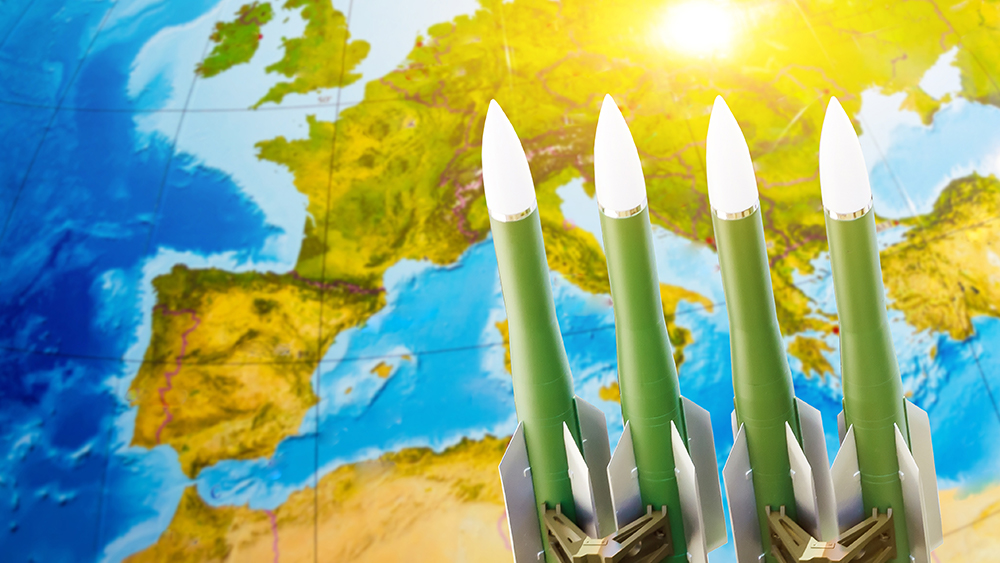America’s weapons stocks: a national security crisis in the making?
12/18/2024 / By Willow Tohi

- The ongoing conflict in Ukraine has significantly depleted U.S. weapons inventories, raising concerns about the nation’s readiness to defend itself against future threats.
- A CSIS study reveals that replenishing critical systems, such as the FIM-92 Stinger missile, could take up to 18 years, with accelerated production still requiring 6.5 years for the Stinger alone.
- High usage of 155 mm shells in Ukraine (143,000 rounds per month) and other critical systems like Javelin missiles strain U.S. supply lines, with replenishment timelines of 6–7 years or more.
- The Defense Department plans to increase 155 mm shell production to 40,000 per month by 2025 and explore foreign purchases, but these measures will take years to address shortages.
- The U.S. must prioritize rebuilding its own stockpiles while continuing to support Ukraine, as neglecting either could jeopardize national security and global stability.
The ongoing conflict in Ukraine has placed immense strain on America’s weapons inventories, raising serious concerns about the nation’s readiness to defend itself in the face of future threats. A recent study by the Center for Strategic and International Studies (CSIS) reveals that replenishing depleted U.S. stockpiles could take up to 18 years for certain critical systems, a timeline that underscores the urgent need for action to address this growing vulnerability.
The study highlights the significant challenges facing the U.S. military as it continues to supply Ukraine with billions of dollars in weapons and munitions. Among the most alarming findings is the projected 18-year timeline to replenish the FIM-92 Stinger missile, a portable air-defense system that has been a cornerstone of U.S. support for Ukraine. The U.S. has transferred 1,600 Stinger systems to Ukraine, and even with accelerated production, it would take 6.5 years to rebuild the inventory.
The challenges extend beyond the Stinger. The study examines six critical systems, including artillery and precision-guided munitions, and finds that only one – the M142 High Mobility Artillery Rocket System (HIMARS) – could be replaced within five years under optimal conditions. For systems like 155 mm ammunition and the Excalibur precision-guided artillery shell, replenishment could take six to seven years or longer, depending on production rates and continued usage.
The depletion of these stocks is compounded by Ukraine’s heavy reliance on artillery in its conflict with Russia. The high usage rate of 155 mm shells, estimated at 143,000 rounds per month, risks further straining U.S. supply lines. While smaller munitions and other resources remain in surplus, critical systems like the Javelin anti-tank missile and precision-guided munitions face similar replenishment challenges.
The Department of Defense (DOD) has taken steps to address these shortages, including plans to increase 155 mm shell production from 3,250 per month to 40,000 per month by 2025. However, manufacturing lead times of 24 months or more make this a daunting task. The DOD has also explored foreign purchases of munitions and multiyear procurement contracts to incentivize manufacturers to expand capacity, but these measures will take years to yield results.
The CSIS report warns of a potential “crisis brewing” over artillery ammunition and other key systems, signaling the need for urgent action to secure U.S. and global security interests. The study concludes that the U.S. may need to accept increased risk in its inventory levels or rely more heavily on allied contributions to sustain Ukraine’s defense capabilities.
We have to help ourselves before we help others
For now, the situation raises critical questions about the balance between current aid commitments and future readiness. As the U.S. continues to support Ukraine, it must also ensure that its own military is prepared to face potential threats from adversaries like China and Russia. The depletion of weapons stocks has already forced the suspension of further Javelin transfers to Ukraine, highlighting the risks of undercutting U.S. war plans in other regions.
The Army’s chief weapons buyer, Doug Bush, has acknowledged the need for a “dramatic” increase in ammunition production, with plans to triple 155 mm shell production over the next few years. However, the defense industry’s lack of robust production capacity, a result of historically “lumpy” military purchases, complicates this effort. Industry executives have expressed concerns about expanding capacity without a clear, long-term demand signal from the government.
Congress has provided significant funding and authorities to address these challenges, including multiyear procurement contracts and streamlined purchasing processes. However, the timeline for rebuilding inventories remains lengthy, and the U.S. must carefully manage its resources to avoid a future national security crisis.
As the conflict in Ukraine continues, the U.S. faces a difficult choice: prioritize immediate aid to Ukraine or focus on rebuilding its own depleted stockpiles. The CSIS report makes clear that the U.S. cannot afford to neglect either priority. The nation must act swiftly to bolster its industrial base, accelerate production and ensure that its military remains ready to defend against any threat.
The stakes are high, and the clock is ticking. America’s national security depends on its ability to replenish its weapons stocks and maintain its military edge. The question is not whether the U.S. can afford to act, but whether it can afford not to.
Sources include:
Submit a correction >>
Tagged Under:
big government, chaos, Collapse, Dangerous, HIMARS, insanity, Israel, military tech, national defense, national security, scarcity, Ukraine, weapons stocks, weapons tech, WWIII
This article may contain statements that reflect the opinion of the author
RECENT NEWS & ARTICLES
COPYRIGHT © 2017 COLLAPSE.NEWS
All content posted on this site is protected under Free Speech. Collapse.news is not responsible for content written by contributing authors. The information on this site is provided for educational and entertainment purposes only. It is not intended as a substitute for professional advice of any kind. Collapse.news assumes no responsibility for the use or misuse of this material. All trademarks, registered trademarks and service marks mentioned on this site are the property of their respective owners.




















